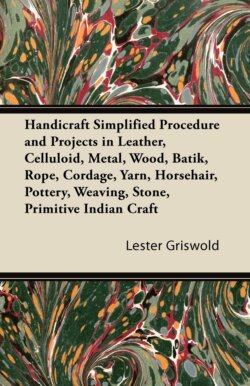Читать книгу Handicraft Simplified Procedure and Projects in Leather, Celluloid, Metal, Wood, Batik, Rope, Cordage, Yarn, Horsehair, Pottery, Weaving, Stone, Primitive Indian Craft - Lester Griswold - Страница 38
На сайте Литреса книга снята с продажи.
METHODS OF DECORATING LEATHER
ОглавлениеSealing Wax Inlays for background or design areas are made by first cutting around the outline of the area to be inlaid with a sharp knife. Depth of cut should be about one-fourth to one-half the thickness of the leather.
Have the area moist enough to take a deeply stippled background stamp. Hammer the stippled surface down to the level of the knife cuts. Moisten the stippled surface with grain alcohol, before applying the sealing wax. Flow the sealing wax—dissolved in grain alcohol, into the depressed area with a small round brush about 1/16″ diameter and 1/4″ bristle, and work the wax well up to the edge of the design outline to secure a good bond. In about 24 hours the wax will dry smooth and glossy and present the appearance of a mosaic inlay.
Sealing wax inlays are best made on the heavier calf or cowhide leathers and used for articles that are not subjected to much bending. It has been successfully used on Quivers, Hatbands, Mats, Blotter Pad Corners, etc.
Articles made from unglazed strap leather may be colored or stained as described on page 47. Dyes, stains, or the India Inks are best for articles which may be subjected to bending. On other articles, the lacquer paints may be successfully applied.
Applying Metal Ornaments.
Another method of decoration is found in the use of brass, nickel. silver, also jeweled ornaments.
The procedure in laying out a rosette with the pine tree stamping tool is indicated in Sketches a, b, c. The method of applying a jeweled ornament is illustrated by Sketches D, E and F.
